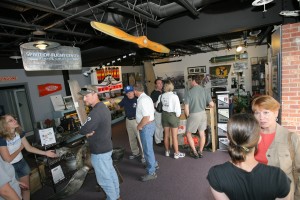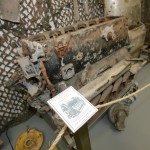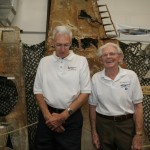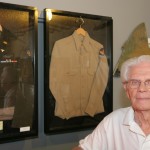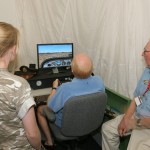
WWII P-51 pilot James S. “Pete” Peterson (left) and Gordon R. Page stand in front of the Spirit of Flight Center’s restored Wright Cyclone R-1820 engine.
By Reggie Paulk
On September 23, the Colorado Spirit of Flight Center, located in Lafayette, Colo., held its fall open house. Among the many offerings available were aviation artifacts, including a restored Wright Cyclone R-1820 engine displayed prominently in front of the building. The R-1820 powered the mighty B-17 Flying Fortresses over the European battlefield during World War II.
Immediately inside the front entrance, a battered three-blade propeller faces the door. The two bottom blades are bent, dirt is lodged inside the hub and the top blade has holes in it. A small display card reveals that this propeller belonged to a German Messerschmitt BF-109 fighter, shot down by a Russian IL-2.
The main exhibition area contains a collage that represents some of the individual aviators of WWII. Along the right side of the aisle are crumpled piles of metal: wings of another Messerschmitt BF-109 that nose-dived into the ground. Visitors can still make out the faint blue paint and an Iron Cross.
Immediately adjacent to the crumpled wing is the severed vertical stabilizer of yet another 109, its swastika still clearly visible. Standing only inches away from an actual German war machine with original markings sends chills down the spine. That’s a good thing; it’s what the collection’s curator wants people to feel.
Curator Gordon R. Page is the consummate aviation fanatic. He traveled to Russia in the early 1990s to pursue a lifelong dream of recovering a working WWII airplane. The effort was so dangerous, he later wrote “Warbird Recovery,” a book about his adventure. His Spirit of Flight Center exists in part because of those efforts. But education is the main reason he opened the center.
By way of explanation, Page relayed a story about a teenager who asked an innocent question.
“A high school kid came in and saw ‘WWII’ on one of the items. He came up to me and asked, ‘Do you have Wi-Fi in here?’ I said, ‘Why would you ask that?’ He replied, ‘It says over there, “WWII.”‘ Amazed, I said, ‘World War II.’ He said, ‘Yeah, I’ve heard of that,’ and walked off. That was the day I became dedicated to building a different kind of collection.”
The encounter led Page to make his collection more accessible than most.
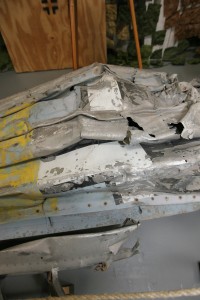
Visitors can still make out faint blue paint and an Iron Cross on the underside of this crumpled Messerschmitt BF-109 wing.
“Our facility is a little bit different,” he explains. “We make our collection more approachable. You can walk up, touch the prop, put your finger through the bullet hole and go, ‘Man, this is the real thing!’ It’s unlike the Smithsonian or some other collections, where you can’t touch anything. There are items back there like the stabilizer with the swastika; you won’t see that outside the Smithsonian.”
As part of the open house, Page invited a few WWII vets who’ve donated personal artifacts to the center. One who attended was James S. “Pete” Peterson, a P-51 pilot during the latter part of the war. His dress uniform is displayed in the main lobby, and he’s pictured nearby in a vintage group photo.
“Our approach is real stories, real history from guys like Pete,” Page continued. “He’s our next-door neighbor, but we never realized he was defending our country during the war, flying a fighter, bomber or something like that. We’ll borrow photographs, documents, letters and other items, scan them or photograph them and then send all of the originals back. Then we’ll create their stories in a collage. These are part of what we call the Hall of Honor, when you first walk in.”
Visitors wouldn’t expect to be moved so deeply after entering the center; it’s just a plain, brick building, with a small glass door. It’s easy to miss. The treasures housed within, however, are worth a look, even by those who aren’t very interested in WWII. Exposure to genuine artifacts has a profound effect on people, and the center presents its wares in an intimate fashion unmatched by many collections.
Take the time to visit; you’ll be glad you did.
For more information about the Colorado Spirit of Flight Center, visit [http://www.spiritofflight.com].
- This DB601 E is an inverted V-12, which powered the Messerschmitt 109.
- George Meshko, joined by Nancy, his wife of more than 60 years, stands with a collage that includes his original A2 flying jacket with his nickname “Rush” still visible. He was a waist gunner in the B-17 during the war.
- Jim Rice (left), president of the 8th Air Force Historical Society, shares a laugh with Pete Peterson in front of the Spirit of Flight Center’s BF-109 wings. The Iron Cross is still plainly visible on the wing over Rice’s right shoulder.
- Pete Peterson stands next to cases containing the dress uniform he wore more than 60 years ago.
- After his P-51 suffered irreparable damage, Pete Peterson had to get home on this B-17. He’s pointing to himself in the photo.
- Using this flight simulator, the Spirit of Flight Center offers a small taste of what it’s like to fly a WWII German fighter.
- The broken tail of a BF-109 still clearly shows its swastika, 60 years after being shot down.












